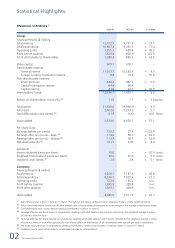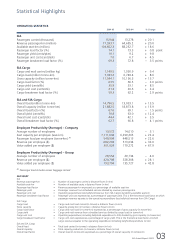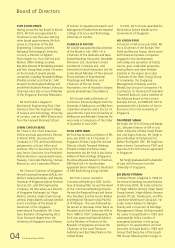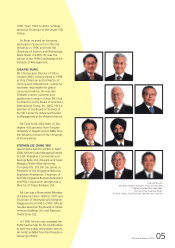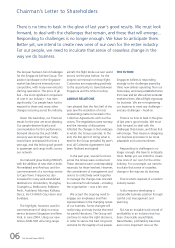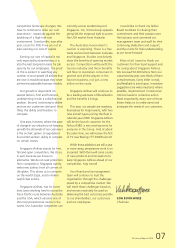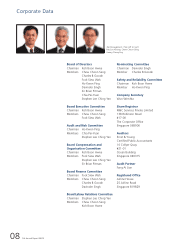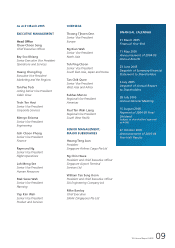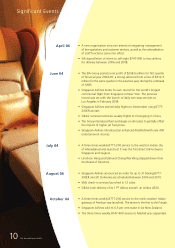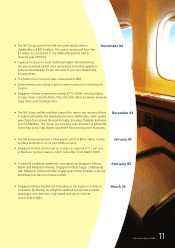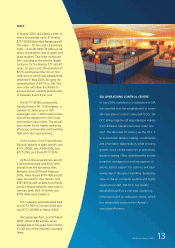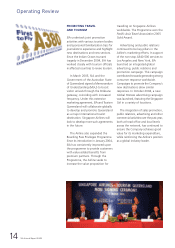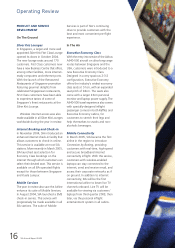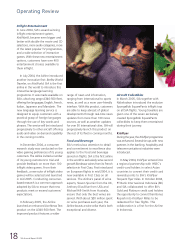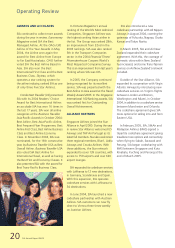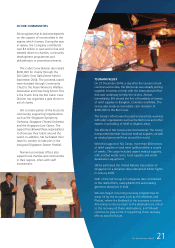Singapore Airlines 2005 Annual Report Download - page 14
Download and view the complete annual report
Please find page 14 of the 2005 Singapore Airlines annual report below. You can navigate through the pages in the report by either clicking on the pages listed below, or by using the keyword search tool below to find specific information within the annual report.
THE YEAR IN REVIEW
This financial year saw Singapore
Airlines make steady progress on its
recovery from the year before.
Singapore Airlines posted an operating
profit of $1.36 billion for the year,
reinforcing a period of positive
growth. A range of new products and
services were introduced on the
ground and inflight.
The Company also rationalised its
organisational structure. Certain IT
and finance functions were outsourced
and new Collective Agreements were
signed with all unions.
The Airline continues to make
steady progress towards the entry of
the A380 aircraft into commercial
service. First to fly the A380, Singapore
Airlines is set to usher in a new dawn
for aviation with this aircraft: the first
totally new commercial aircraft in over
a decade.
While the Airline's recovery
gathered pace, it was again reminded
of the adverse impact of events
beyond its control, such as the Indian
Ocean tsunami disaster. The Company
continues to adapt itself to face similar
challenges inherent in the current
aviation and tourism industries.
NETWORK
With the SARS pandemic over,
Singapore Airlines expanded its
network to cater to a global increase
in demand for air travel. The highlight
of the year was the launch of a daily
non-stop A340-500 service between
Singapore and New York's Newark
airport in June 2004. In launching this
service, SIA broke its own record for
the world’s longest commercial flight.
The year also saw the Company
expand its network to India. Three-
times-weekly B777-200 services were
launched to Ahmedabad and Amritsar.
These new flights, coupled with
additional flights to Bangalore,
Kolkata and Mumbai, as well as the
use of larger aircraft to Chennai for
the year-end peak, translated to a 40
per cent increase in capacity over the
last year.
12 SIA Annual Report 04/05
Operating Review
Services to Australia were also
boosted in the period under review.
With additional services to Adelaide,
Brisbane, Melbourne and Perth, SIA
operated 85 times weekly into Australia
by the end of the year in review.
In June, Singapore Airlines began
daily B777-200ER operations to
Amsterdam. In October, the Airline
suspended its B747-400 service to
Madrid and replaced it with codeshare
services using its Star Alliance partners.
SIA’s services to Europe increased from
66 to 69 times a week.
As part of restructuring the network
to South Africa, Singapore Airlines
launched a weekly non-stop B777-
200ER service to Cape Town, saving
customers two and quarter hours of
travel time. This service, the first ever
direct air link between Cape Town and
South East Asia, brings the Airline's
weekly frequencies to South Africa to
eight. Growth in the Company's
network also came from increasing
frequencies to Christchurch, Fukuoka
and Hanoi to daily.
As at 31 March 2005, SIA's
passenger network consisted of 668
weekly flights to 60 destinations in
32 countries.


